|
Power Class
In 5G New Radio (NR), maximum output power levels are categorized into different power classes to support various use cases and device types. Setting appropriate power classes is an important part of configuring both user equipment (UE) and base stations to ensure adequate coverage and quality of service while minimizing interference.
In every cellular technology from 2G through 5G, Power classes are vital for defining the transmission power levels of devices and base stations. These classifications help in optimizing network performance, managing interference, and ensuring efficient energy usage. Different power classes are designated for various types of devices, from high-power base stations to low-power
Internet of Things (IoT) devices. Understanding these power classes is crucial for network designers, device manufacturers, and telecom operators
The available and configured power class impacts factors like coverage area, link budget, and interference. Careful selection of power classes for NR deployments is necessary to meet performance requirements.
UE type and Power Class
The P_PowerClass varies and the class is specified in 3GPP as follows. Short summary of these tables are as follows. This table is the one specifed for FR2, but I think it loosely matches with FR1 use case as well. You may check out this article from 3GPP for FR1 use cases.
< 38.101-2 v17.11 - Table 6.2.1.0-1: Assumption of UE Types >

FR1 Power Class
In FR1 four different power classes are defined and supportability of each power class varies depending on band, but all bands support class 3 by default.
Followings are power class that are supported by frequency range and each band
-
Class 1: Generally targeting fixed-wireless and vehicle-mounted use case and high-power scenarios like public safety, with maximum power around 31 dBm for selected bands, indicating these are for devices requiring the strongest signal transmission capabilities.
- Class 1.5: Targeted for operation in NR bands n77 and n78, addressing the needs of smartphones and fixed wireless access devices, with specific UE requirements including maximum output power and a new duty cycle capability, featuring a maximum power of 29 dBm, which suggests a mid-range power requirement between Class 1 and Class 2.
- Class 2: For NR TDD intra-band Carrier Aggregation (CA) and HPUE(High Power UE), max power is 26 dBm
- Class 3: Identified as the default class unless otherwise specified, with a consistent maximum power of 23 dBm across all bands, suitable for general use cases and possibly optimized for better power efficiency
< 38.101-1 v17.11 : Table 6.2.1-1: UE Power Class >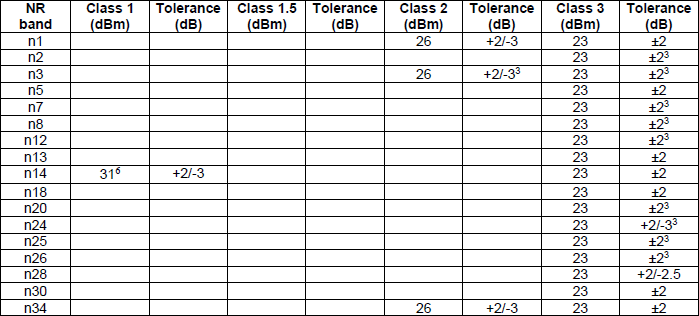
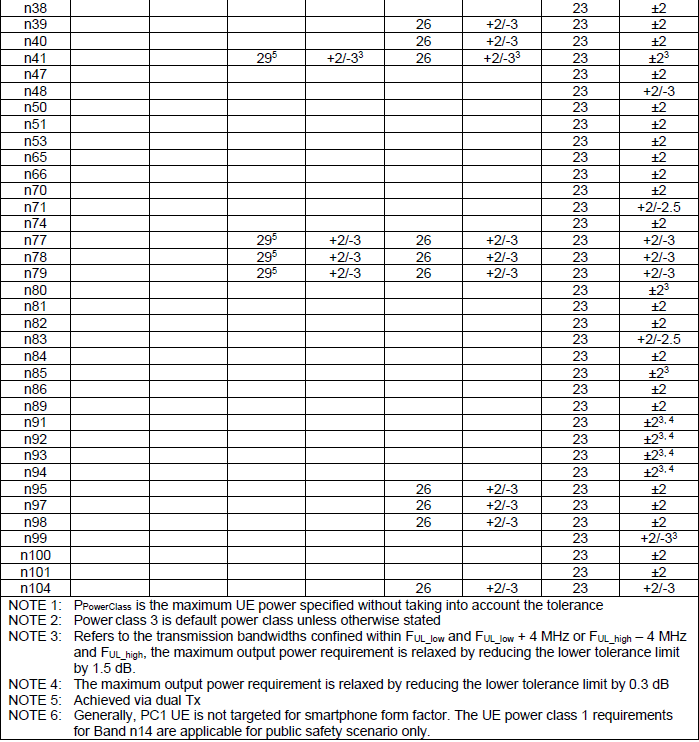
FR2 Power Class
Each power class is tailored to different device requirements and use cases within the 5G NR spectrum, ensuring that a range of devices can operate efficiently and effectively within the set power constraints, from high-power base stations to low-power IoT devices. The specifications for these power classes are critical for compliance with 5G standards and for the optimization of network
performance, coverage, and device interoperability.
Followings are short summary for each power class :
- Power Class 1: Fixed wireless access (FWA) UEs, with high minimum peak EIRP values around 40 dBm and maximum EIRP up to 55 dBm, designed for robust transmission and extensive coverage.
- Power Class 2: Vehicular UEs, featuring minimum peak EIRP values around 29 dBm and maximum EIRP at 43 dBm, balancing coverage and power efficiency for mobility.
- Power Class 3: Handheld UEs, with lower power outputs, minimum peak EIRP in the range of 22.4 to 30.4 dBm, and maximum EIRP of 43 dBm, suitable for general consumer use.
- Power Class 4: High power non-handheld UEs, maintaining minimum peak EIRP levels around 34 dBm and maximum EIRP levels of 43 dBm, focusing on high performance in non-mobile settings.
- Power Class 5: Fixed wireless access (FWA) UEs, with minimum peak EIRP levels set around 30 dBm and a maximum EIRP of 43 dBm, optimizing for stationary setups with efficient energy usage.
- Power Class 6: High Speed Train Roof-Mounted UEs, with moderate minimum peak EIRP at 30 dBm and a consistent maximum EIRP of 43 dBm, tailored for the high-speed connectivity requirements of rail transport.
- Power Class 7: RedCap (Reduced Capability) UEs, the lowest power devices in this list, with minimum peak EIRP at 16.4 dBm and maximum EIRP of 43 dBm, designed for less demanding applications and devices.
Class 1
The characteristics of power class 1 for each of FR2 band can be summarized as follows :
- Minimum Peak EIRP (Equivalent Isotropically Radiated Power):
- For bands n257, n258 and n261, the minimum peak EIRP is 40.0 dBm.
- For band n260, it is 38.0 dBm
- For band n262, it is 34.2 dBm.
- For band n263, it is lower, at 30.6 dBm.
- The minimum peak EIRP is defined as the lower limit without tolerance.
- Maximum Output Power Limits:
- The maximum Transmission Power (TRP) for bands n257, n258, n260, n261, and n262 is 35 dBm, while for band n263, it is 25 dBm.
- The maximum EIRP for bands n257, n258, n260, n261, and n262 is 55 dBm. For band n263, the maximum EIRP is reduced to 40 dBm.
- UE Spherical Coverage:
- This table defines the minimum EIRP at 85%-tile Cumulative Distribution Function (CDF) for spherical coverage.
- The values for bands n257, n258 and n261 are set at 32.0 dBm.
- The value for n260 is set at 30.0 dBm
- For band n262, it is 26.0 dBm.
- Band n263 has the lowest with 19.1 dBm.
- The minimum EIRP at 85%-tile CDF is the lower limit without tolerance and these requirements are verified under normal temperature conditions
< 38.101-2 v17.11 Table 6.2.1.1-1: UE minimum peak EIRP for power class 1 >

< 38.101-2 v17.11 Table 6.2.1.1-2: UE maximum output power limits for power class 1 >

< 38.101-2 v17.11 Table 6.2.1.1-3: UE spherical coverage for power class 1 >
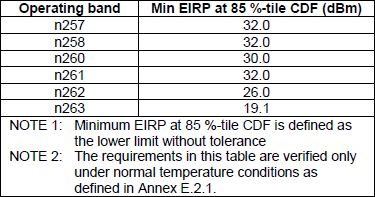
Class 2
The characteristics of power class 2 for each of FR2 band can be summarized as follows :
< 38.101-2 v17.11 Table 6.2.1.2-1: UE minimum peak EIRP for power class 2 >

< 38.101-2 v17.11 Table 6.2.1.2-2: UE maximum output power limits for power class 2 >

< 38.101-2 v17.11 Table 6.2.1.2-3: UE spherical coverage for power class 2 >
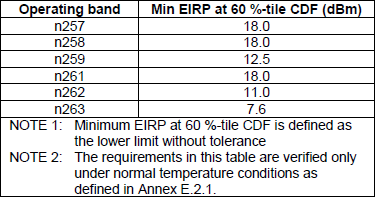
Class 3
The characteristics of power class 3 for each of FR2 band can be summarized as follows :
< 38.101-2 v17.11 Table 6.2.1.3-1: UE minimum peak EIRP for power class 3 >
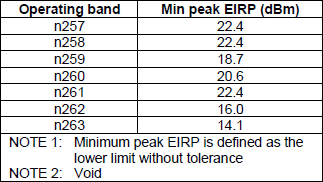
< 38.101-2 v17.11 Table 6.2.1.3-2: UE maximum output power limits for power class 3 >
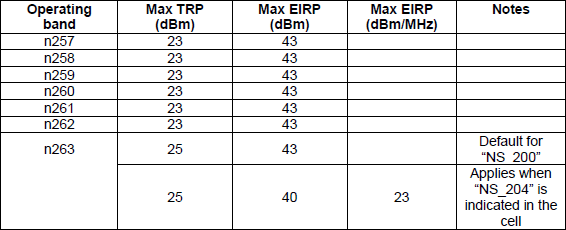
< 38.101-2 v17.11 Table 6.2.1.3-3: UE spherical coverage for power class 3 >
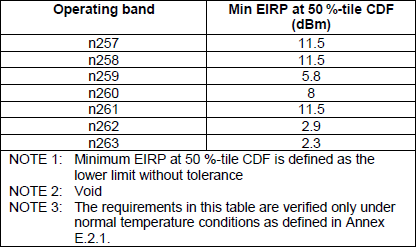
< 38.101-2 v17.11 Table 6.2.1.3-4: UE multi-band relaxation factors for power class 3 >
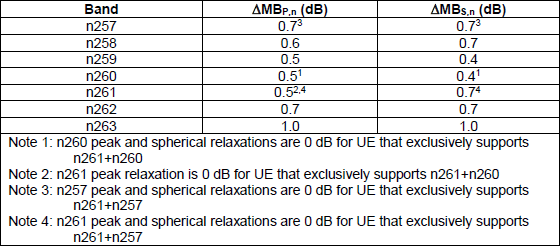
Class 4
The characteristics of power class 4 for each of FR2 band can be summarized as follows :
- Minimum Peak EIRP:
- Bands n257,n258 and n261 have the highest minimum peak EIRP at 34 dBm.
- Band n260 has a minimum of 31 dBm
- Band n262 has the lowest at 28.3 dBm.
- The minimum peak EIRP is noted as the lower limit without tolerance.
- Maximum Output Power Limits:
- For all listed bands (n257,n258,n260,n261,n262), the maximum TRP (Transmission Power) is consistent at 23 dBm.
- The maximum EIRP for all these bands is also consistent at 43 dBm.
- UE Spherical Coverage:
- The minimum EIRP at 20%-tile CDF varies across bands: n257, n258 and n261 are at 25 dBm, n260 is at 19 dBm and n262 has the lowest at 16.2 dBm.
- The minimum EIRP at 20%-tile CDF is defined as the lower limit without tolerance and these requirements are verified under normal temperature conditions
< 38.101-2 Table 6.2.1.4-1: UE minimum peak EIRP for power class 4 >
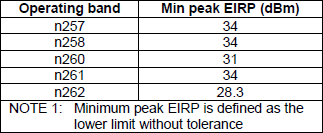
< 38.101-2 Table 6.2.1.4-2: UE maximum output power limits for power class 4 >

< 38.101-2 Table 6.2.1.4-3: UE spherical coverage for power class 4 >
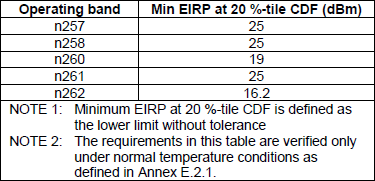
Class 5
The characteristics of power class 5 for each of FR2 band can be summarized as follows :
- Minimum Peak EIRP:
- Band n257 has a minimum peak EIRP of 30 dBm.
- Band n258 is at 30.4 dBm.
- Band n259 is the lowest at 27.7 dBm.
- These values represent the lower limit without tolerance.
- Maximum Output Power Limits:
- The maximum TRP for bands n257, n258, and n259 is set at 23 dBm.
- The maximum EIRP for all these bands is consistently at 43 dBm.
- UE Spherical Coverage:
- The minimum EIRP at 85%-tile CDF for band n257 is 22 dBm, for n258 is 22.4 dBm, and for n259 is 19.7 dBm.
- The minimum EIRP values are the lower limits without tolerance and are verified under normal temperature conditions
- UE Multi-band Relaxation Factors:
- For band n257 and n258, the relaxation factors ΔMBPn and ΔMBSn are both 0.7 dB.
- Band n259 has a relaxation factor of 0.5 dB for both ΔMBPn and ΔMBSn.
< 38.101-2 Table 6.2.1.5-1: UE minimum peak EIRP for power class 5 >

< 38.101-2 Table 6.2.1.5-2: UE maximum output power limits for power class 5 >

< 38.101-2 Table 6.2.1.4-3: UE spherical coverage for power class 5 >
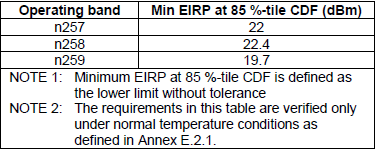
< 38.101-2 Table 6.2.1.5-4: UE multi-band relaxation factors for power class 5 >

Class 6
The characteristics of power class 6 for each of FR2 band can be summarized as follows :
- Minimum Peak EIRP:
- Bands n257 and n261 have a minimum peak EIRP of 30 dBm.
- Band n268 has a slightly higher minimum peak EIRP of 30.4 dBm.
- The minimum peak EIRP is defined as the lower limit without tolerance.
- Maximum Output Power Limits:
- All three bands, n257, n258, and n261, have the same maximum TRP of 23 dBm.
- The maximum EIRP for these bands is also the same at 43 dBm.
- UE Spherical Coverage Evaluation:
- For bands n257 and n261, the minimum EIRP over UE spherical coverage evaluation areas is 20 dBm.
- Band n258 also has the minimum EIRP at 20.4 dBm.
- These minimum EIRP values are the lower limits without tolerance and are verified under normal temperature conditions.
- UE Spherical Coverage Evaluation Areas:
- The spherical coverage evaluation areas are divided into two areas with different ranges for the θ (theta) and φ (phi) angles.
- Area-1 has a θ range of 90 to 60 degrees and a φ range of -37.5 to +37.5 degrees.
- Area-2 has a θ range of 90 to 60 degrees and a φ range of 142.5 to 217.5 degrees.
- There are additional notes indicating that the orientation of the Device Under Test (DUT) can be determined according to the UE spherical coverage evaluation areas and that for high-speed train deployments, the reference coordination system's θ is expected to be with respect to the ground plane the train is running on.
- UE Multi-band Relaxation Factors:
- For all bands (n257, n258, and n261), the multi-band relaxation factors ΔMBPn and ΔMBSn are both 0.7 dB.
< 38.101-2 Table 6.2.1.6-1: UE minimum peak EIRP for power class 6 >

< 38.101-2 Table 6.2.1.6-2: UE maximum output power limits for power class 6 >

< 38.101-2 Table 6.2.1.6-3: UE spherical coverage for power class 6 >
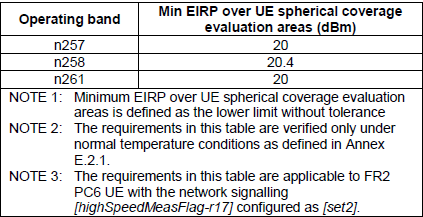
< 38.101-2 Table 6.2.1.6-3a: UE spherical coverage evaluation areas for power class 6 >

< 38.101-2 Table 6.2.1.6-4: UE multi-band relaxation factors for power class 6 >

Class 7
The characteristics of power class 7 for each of FR2 band can be summarized as follows :
- Minimum Peak EIRP:
- For all three bands (n257, n258, n261), the minimum peak EIRP is set at 16.4 dBm.
- The minimum peak EIRP is described as the lower limit without tolerance.
- Maximum Output Power Limits:
- The maximum TRP for these bands is consistent at 23 dBm.
- The maximum EIRP is also the same across the bands at 43 dBm.
- UE Spherical Coverage:
- For spherical coverage, the minimum EIRP at 50%-tile CDF is significantly lower:
- For bands n257 and n258, it is 5.5 dBm.
- For band n261, it is slightly higher at 5.5 dBm.
- This minimum EIRP at 50%-tile CDF is the lower limit without tolerance and is verified under normal temperature conditions
< 38.101-2 Table 6.2.1.7-1: UE minimum peak EIRP for power class 7 >
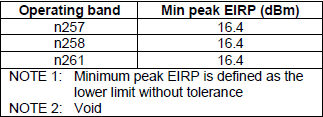
< 38.101-2 Table 6.2.1.7-2: UE maximum output power limits for power class 7 >

< 38.101-2 Table 6.2.1.7-3: UE spherical coverage for power class 7 >
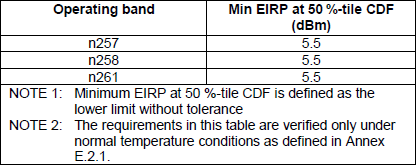
Reference
|
|



























